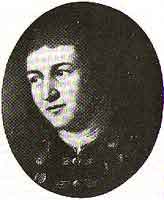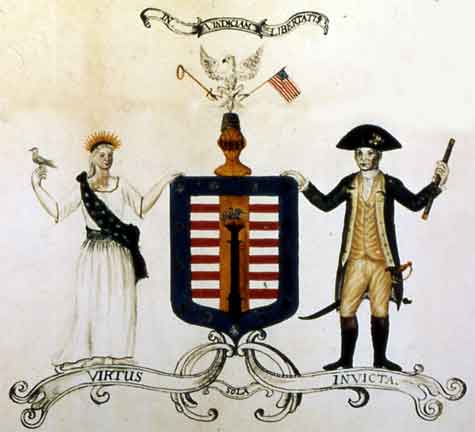William Barton Describes His Design for the Great Seal

One can imagine the honor and excitement experienced by the young William Barton when he was called upon by the Secretary of Congress, Charles Thomson, and two members of Congress, Arthur Lee and Elias Boudinot. They asked this twenty-eight year old Philadelphian to "furnish devices" for the Great Seal of the United States. Part of an accomplished and distinguished family, Barton had acquired a good classical education by the time he was twenty. In 1775 he went to England for three years, where he studied law and gained an extensive knowledge of heraldry.
Back in the United States, Barton (himself the eldest of ten children) married and eventually had nine children. He published pamphlets on banking and paper money, and sometimes worked as an attorney. In 1787, he was elected a member of the American Philosophical Society, the beginning of a long association which included the role of counselor and secretary for the Society. Three years before his death in 1817, Barton published a biography of his famous uncle, David Rittenhouse, the astronomer.

William Barton's remarks offer a fascinating glimpse
into the mind of revolutionary America.
- The Eagle displayed is the Symbol of supreme Power and Authority, and signifies the Congress. Being placed on the Summit of the Column, it is emblematical of the Sovereignty of the Government of the United States.
- The Sword (held by the Eagle) is the symbol of Courage, Authority, and Power.
- The Flag denotes the United States of America, of the Sovereignty of which the Eagle is expressive.
- The Phoenix is emblematical of the expiring Liberty of Britain, revived by her Descendants, in America.
- The Pillar is used as the Hieroglyphic of Fortitude and Constancy; and, its being of the Doric Order, (which is the best proportioned and most agreeable to Nature), whose parts form a beautiful Composition of Strength, Congruity, and Usefulness, it may with great propriety signify a well-planned Government.
- The Dove (perched on the right Hand of the Genius of America) is emblematical of Innocence and Virtue.
- The Genius of the American confederated Republic is denoted by her blue Scarf and Fillet, glittering with Stars. Her Dress is white edged with Green; Colours emblematical of Innocence and Youth. Her purple Girdle and radiated Crown indicate her Sovereignty: the Word "Virtue" on the former is to show, that that should be her principal Ornament; and the radiated Crown, that no Earthly Crown shall rule her.
- The thirteen Stars (in Barton's first design) represent a new Constellation, which alludes to the new Empire, formed in the World by the Confederation of States. Their Disposition, in the form of a Circle, denotes the Perpetuity of its Continuance, the Ring being the Symbol of Eternity.
- The Pyramid signifies Strength and Duration.
 Barton's proposal for the reverse side of the Great Seal is his most significant contribution to the final design. Interestingly, in place of the Eye, Barton had first proposed using a Palm Tree that: "when burnt down to the very Root, naturally rises fairer than ever."
Barton's proposal for the reverse side of the Great Seal is his most significant contribution to the final design. Interestingly, in place of the Eye, Barton had first proposed using a Palm Tree that: "when burnt down to the very Root, naturally rises fairer than ever."
Third Committee
|

